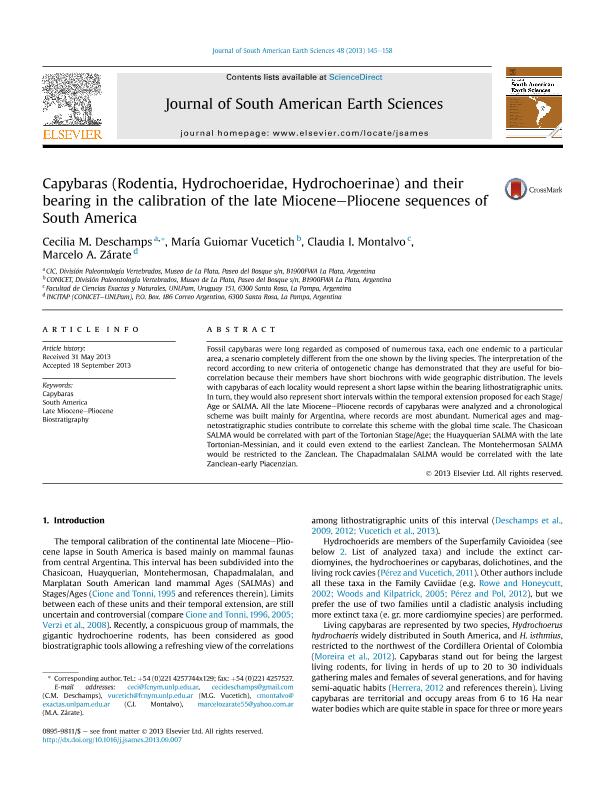Mostrar el registro sencillo del ítem
dc.contributor.author
Deschamps, Cecilia Marcela

dc.contributor.author
Vucetich, María Guiomar

dc.contributor.author
Montalvo, Claudia Inés

dc.contributor.author
Zárate, Marcelo Arístides

dc.date.available
2017-09-05T14:39:11Z
dc.date.issued
2013-09
dc.identifier.citation
Deschamps, Cecilia Marcela; Vucetich, María Guiomar; Montalvo, Claudia Inés; Zárate, Marcelo Arístides; Capybaras (Rodentia, Hydrochoeridae, Hydrochoerinae) and their bearing in the calibration of the late Miocene–Pliocene sequences of South America; Elsevier; Journal of South American Earth Sciences; 48; 9-2013; 145-158
dc.identifier.issn
0895-9811
dc.identifier.uri
http://hdl.handle.net/11336/23662
dc.description.abstract
Fossil capybaras were long regarded as composed of numerous taxa, each one endemic to a particular area, a scenario completely different from the one shown by the living species. The interpretation of the record according to new criteria of ontogenetic change has demonstrated that they are useful for biocorrelation because their members have short biochrons with wide geographic distribution. The levels with capybaras of each locality would represent a short lapse within the bearing lithostratigraphic units. In turn, they would also represent short intervals within the temporal extension proposed for each Stage/ Age or SALMA. All the late MioceneePliocene records of capybaras were analyzed and a chronological scheme was built mainly for Argentina, where records are most abundant. Numerical ages and magnetostratigraphic studies contribute to correlate this scheme with the global time scale. The Chasicoan SALMA would be correlated with part of the Tortonian Stage/Age; the Huayquerian SALMA with the late Tortonian-Messinian, and it could even extend to the earliest Zanclean. The Montehermosan SALMA would be restricted to the Zanclean. The Chapadmalalan SALMA would be correlated with the late Zanclean-early Piacenzian.
dc.format
application/pdf
dc.language.iso
eng
dc.publisher
Elsevier

dc.rights
info:eu-repo/semantics/openAccess
dc.rights.uri
https://creativecommons.org/licenses/by-nc-sa/2.5/ar/
dc.subject
Capybaras
dc.subject
South America
dc.subject
Late Miocene-Pliocene
dc.subject
Bioestratigraphia
dc.subject.classification
Oceanografía, Hidrología, Recursos Hídricos

dc.subject.classification
Ciencias de la Tierra y relacionadas con el Medio Ambiente

dc.subject.classification
CIENCIAS NATURALES Y EXACTAS

dc.title
Capybaras (Rodentia, Hydrochoeridae, Hydrochoerinae) and their bearing in the calibration of the late Miocene–Pliocene sequences of South America
dc.type
info:eu-repo/semantics/article
dc.type
info:ar-repo/semantics/artículo
dc.type
info:eu-repo/semantics/publishedVersion
dc.date.updated
2017-09-01T17:33:51Z
dc.journal.volume
48
dc.journal.pagination
145-158
dc.journal.pais
Países Bajos

dc.journal.ciudad
Ámsterdam
dc.description.fil
Fil: Deschamps, Cecilia Marcela. Universidad Nacional de la Plata. Facultad de Ciencias Naturales y Museo. División Paleontología Vertebrados; Argentina. Consejo Nacional de Investigaciones Científicas y Técnicas; Argentina. Provincia de Buenos Aires. Gobernación. Comisión de Investigaciones Científicas; Argentina
dc.description.fil
Fil: Vucetich, María Guiomar. Universidad Nacional de la Plata. Facultad de Ciencias Naturales y Museo. División Paleontología Vertebrados; Argentina. Consejo Nacional de Investigaciones Científicas y Técnicas; Argentina
dc.description.fil
Fil: Montalvo, Claudia Inés. Universidad Nacional de La Pampa. Facultad de Ciencias Exactas y Naturales; Argentina
dc.description.fil
Fil: Zárate, Marcelo Arístides. Consejo Nacional de Investigaciones Científicas y Técnicas. Instituto de Ciencias de la Tierra y Ambientales de La Pampa. Universidad Nacional de La Pampa. Facultad de Ciencias Exactas y Naturales. Instituto de Ciencias de la Tierra y Ambientales de La Pampa; Argentina
dc.journal.title
Journal of South American Earth Sciences

dc.relation.alternativeid
info:eu-repo/semantics/altIdentifier/url/http://www.sciencedirect.com/science/article/pii/S0895981113001387
dc.relation.alternativeid
info:eu-repo/semantics/altIdentifier/doi/http://dx.doi.org/10.1016/j.jsames.2013.09.007
Archivos asociados
